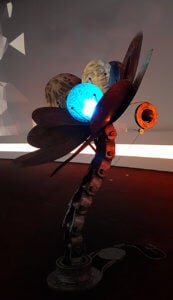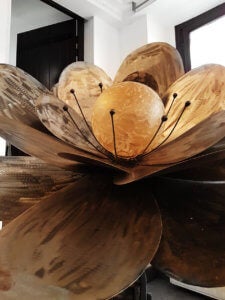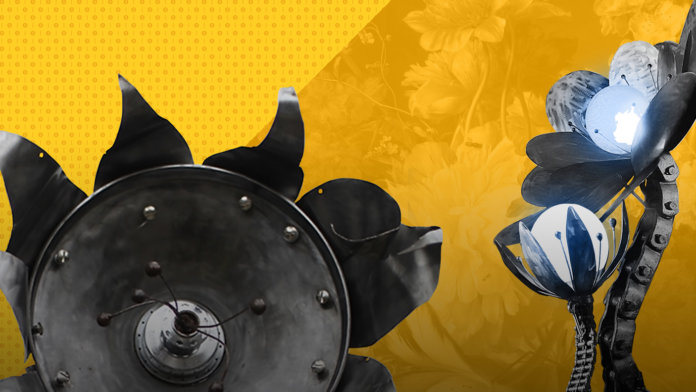This is a thing that exists in the world: a bitcoin-eating plant robot (called a plantoid), made of self-executing computer code which owns itself and hires artists to make its babies. If that sounds like crazy future-speak, welcome to the weird world of DAOs, or distributed autonomous organizations. DAOs, an emerging application of the blockchain, hold the 21st-century-sounding promise that we’ll soon have machine-based life forms and personless organizations milling about our world.

“Plantoid is an attempt at using art to illustrate what I consider to be one of the most innovative and disruptive aspects of the blockchain—the ability to create autonomous entities which are completely independent and self-sufficient,” says Primavera De Filippi, the founder of Okhaos, the art collective behind Plantoid, and a faculty associate at the Berkman-Klein Center at Harvard (and researcher at the CNRS in Paris.)
De Filippi is looking at the way DAOs may enable new types of distributed governance models, ones that may be useful in managing both blockchain-based organizations and existing legacy ones.
What make DAOs like Plantoid so unique is they are capable of managing themselves without anyone there to oversee them. Instead of employees conducting the transactions and exchange of value that connect the organization to the world, self-executing software on the blockchain automates the binding obligations involved in their transactions.
Companies incorporated as DAOs are already grabbing headlines, as demonstrated earlier this year when an employeeless venture fund raised over $160 million from more than 11,000 people in what is, to date, the largest crowdfunding campaign ever launched. Though a hacking scandal later called that particular project into question, we’re likely to see more of these companies, some of which may even have ownership spread across their networks rather than resting in the hands of any people.
What Plantoid also demonstrates is just how far our human-made systems can go in mimicking the mechanisms of the natural world. Though scientists quarrel over what to consider a “life form,” consensus settles around life forms being things capable of taking energy from the environment and translating it into growth and reproduction. And that’s exactly what a Plantoid is designed to do.
The sculpture portion of Plantoid exists to accumulate bitcoin from human admirers, and once it’s earned enough, its code is capable of independently hiring artists who can produce a new version of itself.
A Plantoid takes energy in the form of the digital currency bitcoin and uses the funds to self-replicate. It exists both as a sculpture (a plant version of an android) and as a blockchain smart contract—the self-executing software logic handed down by its creators.
The sculpture portion of Plantoid exists to accumulate bitcoin from human admirers, and once it’s earned enough, its code is capable of independently hiring artists who can produce a new version of itself.
No one ‘owns’ a Plantoid, yet once it’s created, it’s free to grow, expand, and seek out its ecological fit in the world. And just like a real plant, Plantoid is dependent on interactions with other parts of the animal kingdom for survival. Just like a flower might attract a bee to pollinate it with its bright colors and physical shape, Plantoid depends on a particular aesthetic beauty to draw humans in to donate bitcoin.
Eventually, the Plantoid must earn enough money to hire an artist who can make its offspring, and once it does, those who donated bitcoin contribute a vote on which artist (or group of artists) may build the next version. Once a Plantoid has identified those artists, it then autonomously commissions them to design and build a new version of itself and can manage their payment transactions via the smart contract coded into it.

As more Plantoids come into the world, a Darwinian selection also emerges, since Plantoids will be competing among each other for bitcoin. To incentivize the artists creating the varied designs of subsequent Plantoids, the creators behind the project have implemented a system in which each donation paid to a Plantoid pays a small portion as a royalty fee to each of its ancestors and the artists who created them. This system is described by the artists as a necessary pyramid scheme that benefits the system by mimicking the reproductive drive found in nature. The scheme works so Plantoid will pass along the best “genes”—in the form of the most aesthetically appealing work of art—aesthetics that would adapt (like nature) alongside humans’ taste in art over time.
As blockchain technologies proliferate, the line between the natural world and the technological one will blur, and soon our relationship to technology may become more or less like our relationship to nature. Complexity scientist Samuel Arbesman describes how we’ll soon be predicting things like financial irregularities and disruptive computer glitches in the same imperfect way we do weather.
What blockchain provides is the plumbing installation needed for an autonomous infrastructure to function—one that may grow as richly complex and dynamic as the biological world is.
“As a ‘blockchain-based life form,’ the Plantoid brings the concept of autonomy to a whole new level,” says De Filippi.
And this is just the beginning
For a more thorough description of the Plantoid project, head to their website.
Banner Image Credit: Zoe Brinkley (Plantoid images courtesy of Okhaos)



